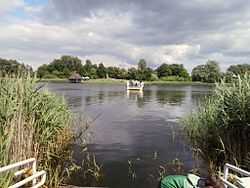Ostrów Lednicki
Coordinates: 52°31′36″N 17°22′40″E / 52.52667°N 17.37780°E


Ostrów Lednicki is an island in the southern portion of Lake Lednica in Poland, located between the cities of Gniezno and Poznań.
A gród (a medieval Slavonic fortified settlement) was built here in the Middle Ages. Existing ruins of a chapel, church and palace, thought to be the home of the first Kings of the Piast dynasty, have been roofed over for preservation. Today the ruins are of archaeological significance, and the site of the Museum of the Piast Dynasty, opened in 1969.[1] It is Poland's largest open-air museum.[2]
The site is one of the Polish National Historic Monuments (Pomnik historii), as one of the first such monuments designated on September 16, 1994. The list of national monuments is maintained by the National Heritage Board of Poland.
Significance
The island is important in the national history of Poland. During the reign of the first ruler of the Polish state, Mieszko I, and Boleslaw the Brave, it stood as one of the main defensive and administrative centers of the kingdom. The ruined castle and other buildings here were constructed during Mieszko I's reign, just before the year 966.
It's also one contender for the historical site of the personal baptism of Mieszko I, his wife Dobrawa of Bohemia, and his entire court, which took place on the Holy Saturday of April 14, 966. This date is the Baptism of Poland, the historical introduction of Christianity in Poland. The event also arguably marks the beginning of the Polish state.[3]
The island is also the scene of Józef Ignacy Kraszewski's historical 1876 novel An Ancient Tale.
References
- ↑ http://www.lednicamuzeum.pl/strona,ostrow-lednicki.html (Polish language)
- ↑ http://www.inyourpocket.com/poland/poznan/Further-Afield/Ostrow-Lednicki
- ↑ >Geneviève Zubrzycki (15 September 2006). The Crosses of Auschwitz: Nationalism And Religion in Post-communist Poland. University of Chicago Press. p. 64. ISBN 978-0-226-99304-1. Retrieved 5 April 2012.
| Wikimedia Commons has media related to Ostrów Lednicki. |